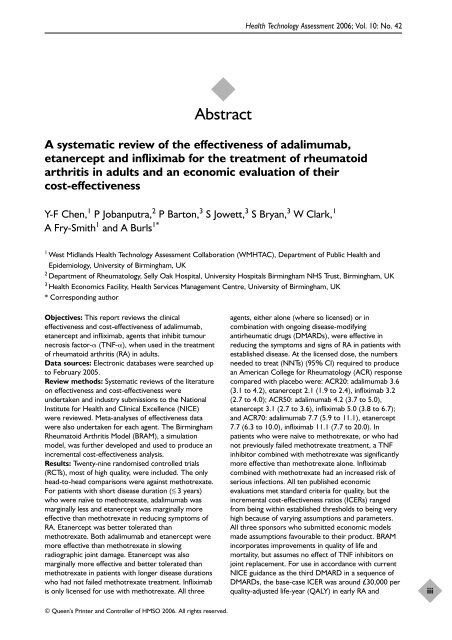A systematic review of the effectiveness of adalimumab
A systematic review of the effectiveness of adalimumab
A systematic review of the effectiveness of adalimumab
You also want an ePaper? Increase the reach of your titles
YUMPU automatically turns print PDFs into web optimized ePapers that Google loves.
Objectives: This report <strong>review</strong>s <strong>the</strong> clinical<br />
<strong>effectiveness</strong> and cost-<strong>effectiveness</strong> <strong>of</strong> <strong>adalimumab</strong>,<br />
etanercept and infliximab, agents that inhibit tumour<br />
necrosis factor- (TNF-), when used in <strong>the</strong> treatment<br />
<strong>of</strong> rheumatoid arthritis (RA) in adults.<br />
Data sources: Electronic databases were searched up<br />
to February 2005.<br />
Review methods: Systematic <strong>review</strong>s <strong>of</strong> <strong>the</strong> literature<br />
on <strong>effectiveness</strong> and cost-<strong>effectiveness</strong> were<br />
undertaken and industry submissions to <strong>the</strong> National<br />
Institute for Health and Clinical Excellence (NICE)<br />
were <strong>review</strong>ed. Meta-analyses <strong>of</strong> <strong>effectiveness</strong> data<br />
were also undertaken for each agent. The Birmingham<br />
Rheumatoid Arthritis Model (BRAM), a simulation<br />
model, was fur<strong>the</strong>r developed and used to produce an<br />
incremental cost-<strong>effectiveness</strong> analysis.<br />
Results: Twenty-nine randomised controlled trials<br />
(RCTs), most <strong>of</strong> high quality, were included. The only<br />
head-to-head comparisons were against methotrexate.<br />
For patients with short disease duration (≤ 3 years)<br />
who were naïve to methotrexate, <strong>adalimumab</strong> was<br />
marginally less and etanercept was marginally more<br />
effective than methotrexate in reducing symptoms <strong>of</strong><br />
RA. Etanercept was better tolerated than<br />
methotrexate. Both <strong>adalimumab</strong> and etanercept were<br />
more effective than methotrexate in slowing<br />
radiographic joint damage. Etanercept was also<br />
marginally more effective and better tolerated than<br />
methotrexate in patients with longer disease durations<br />
who had not failed methotrexate treatment. Infliximab<br />
is only licensed for use with methotrexate. All three<br />
Abstract<br />
© Queen’s Printer and Controller <strong>of</strong> HMSO 2006. All rights reserved.<br />
Health Technology Assessment 2006; Vol. 10: No. 42<br />
A <strong>systematic</strong> <strong>review</strong> <strong>of</strong> <strong>the</strong> <strong>effectiveness</strong> <strong>of</strong> <strong>adalimumab</strong>,<br />
etanercept and infliximab for <strong>the</strong> treatment <strong>of</strong> rheumatoid<br />
arthritis in adults and an economic evaluation <strong>of</strong> <strong>the</strong>ir<br />
cost-<strong>effectiveness</strong><br />
Y-F Chen, 1 P Jobanputra, 2 P Barton, 3 S Jowett, 3 S Bryan, 3 W Clark, 1<br />
A Fry-Smith 1 and A Burls 1*<br />
1 West Midlands Health Technology Assessment Collaboration (WMHTAC), Department <strong>of</strong> Public Health and<br />
Epidemiology, University <strong>of</strong> Birmingham, UK<br />
2 Department <strong>of</strong> Rheumatology, Selly Oak Hospital, University Hospitals Birmingham NHS Trust, Birmingham, UK<br />
3 Health Economics Facility, Health Services Management Centre, University <strong>of</strong> Birmingham, UK<br />
* Corresponding author<br />
agents, ei<strong>the</strong>r alone (where so licensed) or in<br />
combination with ongoing disease-modifying<br />
antirheumatic drugs (DMARDs), were effective in<br />
reducing <strong>the</strong> symptoms and signs <strong>of</strong> RA in patients with<br />
established disease. At <strong>the</strong> licensed dose, <strong>the</strong> numbers<br />
needed to treat (NNTs) (95% CI) required to produce<br />
an American College for Rheumatology (ACR) response<br />
compared with placebo were: ACR20: <strong>adalimumab</strong> 3.6<br />
(3.1 to 4.2), etanercept 2.1 (1.9 to 2.4), infliximab 3.2<br />
(2.7 to 4.0); ACR50: <strong>adalimumab</strong> 4.2 (3.7 to 5.0),<br />
etanercept 3.1 (2.7 to 3.6), infliximab 5.0 (3.8 to 6.7);<br />
and ACR70: <strong>adalimumab</strong> 7.7 (5.9 to 11.1), etanercept<br />
7.7 (6.3 to 10.0), infliximab 11.1 (7.7 to 20.0). In<br />
patients who were naïve to methotrexate, or who had<br />
not previously failed methotrexate treatment, a TNF<br />
inhibitor combined with methotrexate was significantly<br />
more effective than methotrexate alone. Infliximab<br />
combined with methotrexate had an increased risk <strong>of</strong><br />
serious infections. All ten published economic<br />
evaluations met standard criteria for quality, but <strong>the</strong><br />
incremental cost-<strong>effectiveness</strong> ratios (ICERs) ranged<br />
from being within established thresholds to being very<br />
high because <strong>of</strong> varying assumptions and parameters.<br />
All three sponsors who submitted economic models<br />
made assumptions favourable to <strong>the</strong>ir product. BRAM<br />
incorporates improvements in quality <strong>of</strong> life and<br />
mortality, but assumes no effect <strong>of</strong> TNF inhibitors on<br />
joint replacement. For use in accordance with current<br />
NICE guidance as <strong>the</strong> third DMARD in a sequence <strong>of</strong><br />
DMARDs, <strong>the</strong> base-case ICER was around £30,000 per<br />
quality-adjusted life-year (QALY) in early RA and<br />
iii
















